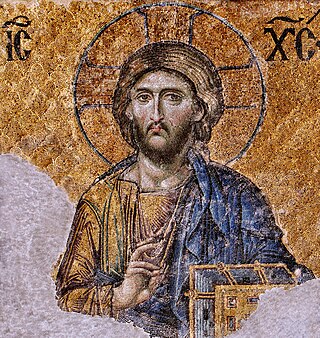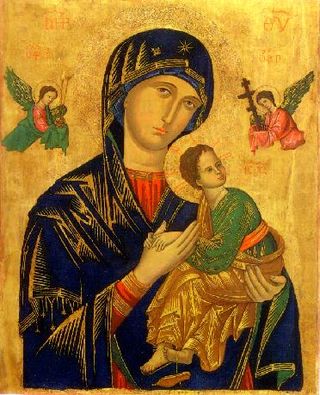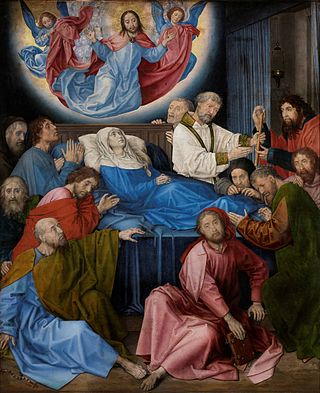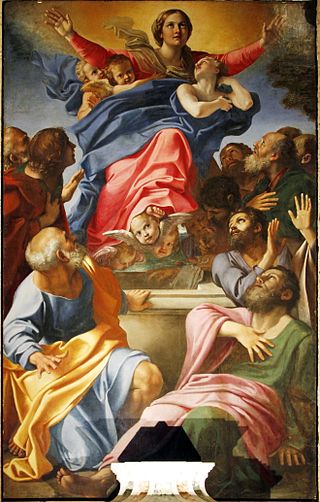
Mary was a first-century Jewish woman of Nazareth, the wife of Joseph and the mother of Jesus. She is a central figure of Christianity, venerated under various titles such as virgin or queen, many of them mentioned in the Litany of Loreto. The Eastern and Oriental Orthodox, Church of the East, Catholic, Anglican, and Lutheran churches believe that Mary, as mother of Jesus, is the Mother of God. Other Protestant views on Mary vary, with some holding her to have considerably lesser status.

The Assumption of Mary is one of the four Marian dogmas of the Catholic Church. Pope Pius XII defined it on 1 November 1950 in his apostolic constitution Munificentissimus Deus as follows:
We proclaim and define it to be a dogma revealed by God that the immaculate Mother of God, Mary ever virgin, when the course of her earthly life was finished, was taken up body and soul into the glory of heaven.

The Dormition of the Mother of God is a Great Feast of the Eastern Orthodox, Oriental Orthodox, and Eastern Catholic Churches. It celebrates the "falling asleep" (death) of Mary the Theotokos, and her being taken up into heaven. It is celebrated on 15 August as the Feast of the Dormition of the Mother of God. The Armenian Apostolic Church celebrates the Dormition not on a fixed date, but on the Sunday nearest 15 August. In Western Churches the corresponding feast is known as the Assumption of Mary, with the exception of the Scottish Episcopal Church, which has traditionally celebrated the Falling Asleep of the Blessed Virgin Mary on 15 August.

Martin Schongauer, also known as Martin Schön or Hübsch Martin by his contemporaries, was an Alsatian engraver and painter. He was the most important printmaker north of the Alps before Albrecht Dürer, a younger artist who collected his work. Schongauer is the first German painter to be a significant engraver, although he seems to have had the family background and training in goldsmithing which was usual for early engravers.

In the Eastern Orthodox Church, the feast of the Resurrection of Jesus, called Pascha (Easter), is the greatest of all holy days and as such it is called the "feast of feasts". Immediately below it in importance, there is a group of Twelve Great Feasts. Together with Pascha, these are the most significant dates on the Orthodox liturgical calendar. Eight of the great feasts are in honor of Jesus Christ, while the other four are dedicated to the Virgin Mary — the Theotokos.

A doubting Thomas is a skeptic who refuses to believe without direct personal experience — a reference to the Gospel of John's depiction of the Apostle Thomas, who, in John's account, refused to believe the resurrected Jesus had appeared to the ten other apostles until he could see and feel Jesus's crucifixion wounds.

Death of the Virgin (1606) is a painting by the Italian Baroque master Caravaggio depicting the death of the Virgin Mary. It is part of the permanent collection of the Musée du Louvre, in Paris.

The Assumption of the Virgin Mary does not appear in the New Testament, but appears in apocryphal literature of the 3rd and 4th centuries, and by 1000 was widely believed in the Western Church, though not made formal Catholic dogma until 1950. It first became a popular subject in Western Christian art in the 12th century, along with other narrative scenes from the Life of the Virgin, and the Coronation of the Virgin. These "Marian" subjects were especially promoted by the Cistercian Order and Saint Bernard of Clairvaux.

The Death of the Virgin is a painting by the Italian Renaissance painter Andrea Mantegna, dating to c. 1462–1464.

The Adoration of the Magi or Uffizi Triptych is a group of three tempera-on-panel paintings by Andrea Mantegna, dating to around 1460. Their three subjects are the Ascension of Christ, Adoration of the Magi the largest and central panel and the Circumcision of Christ. They were gathered as a trio in the 19th century, although some art historians doubt that they were created as a triptych set in the way they are now arranged. They are now in the Uffizi Gallery in Florence.

The Coronation of the Virgin or Coronation of Mary is a subject in Christian art, especially popular in Italy in the 13th to 15th centuries, but continuing in popularity until the 18th century and beyond. Christ, sometimes accompanied by God the Father and the Holy Spirit in the form of a dove, places a crown on the head of Mary as Queen of Heaven. In early versions the setting is a Heaven imagined as an earthly court, staffed by saints and angels; in later versions Heaven is more often seen as in the sky, with the figures seated on clouds. The subject is also notable as one where the whole Christian Trinity is often shown together, sometimes in unusual ways. Crowned Virgins are also seen in Eastern Orthodox Christian icons, specifically in the Russian Orthodox church after the 18th century. Mary is sometimes shown, in both Eastern and Western Christian art, being crowned by one or two angels, but this is considered a different subject.

Mary, the mother of Jesus in Christianity, is known by many different titles, epithets, invocations, and several names associated with places.

The account of the beheading of Holofernes by Judith is given in the deuterocanonical Book of Judith, and is the subject of many paintings and sculptures from the Renaissance and Baroque periods. In the story, Judith, a beautiful widow, is able to enter the tent of Holofernes because of his desire for her. Holofernes was an Assyrian general who was about to destroy Judith's home, the city of Bethulia. Overcome with drink, he passes out and is decapitated by Judith; his head is taken away in a basket.

Mary has been one of the major subjects of Western Art for centuries. There is an enormous quantity of Marian art in the Catholic Church, covering both devotional subjects such as the Virgin and Child and a range of narrative subjects from the Life of the Virgin, often arranged in cycles. Most medieval painters, and from the Reformation to about 1800 most from Catholic countries, have produced works, including old masters such as Michelangelo and Botticelli.

The Lamentation of Christ is a very common subject in Christian art from the High Middle Ages to the Baroque. After Jesus was crucified, his body was removed from the cross and his friends mourned over his body. This event has been depicted by many different artists.

The Ascension of Jesus to Heaven as stated in the New Testament has been a frequent subject in Christian art, as well as a theme in theological writings.

The Death of the Virgin is an oil on oak panel by the Flemish painter Hugo van der Goes. Completed c 1472–80, it shows the Virgin Mary on her deathbed surrounded by the Twelve Apostles. The scene is borrowed from Jacobus de Voragine's thirteenth-century "Legenda aurea" which relates how the apostles were brought, at Mary's request, on clouds by angels to a house near Mount Zion to be with her in her final three days. On the third day Jesus appeared above her bed in a halo of light surrounded by angels to accept her soul at the point when his name was finally mentioned. Three days later he reappeared to accept her body.
The Death of the Virgin is a common subject in Christian art, depicting the death of the Virgin Mary.
The Death of the Virgin acquired in 1944 by the Legion of Honor Art Museum in San Francisco is an oil painting on a panel created sometime in the late fifteenth century in Swabia, Germany by an unknown artist, portraying the Virgin Mary surrounded by the twelve apostles. The subject has been painted by several other anonymous masters of the Death of the Virgin.

The Assumption of the Virgin by Annibale Carracci is the altarpiece of the famous Cerasi Chapel in the church of Santa Maria del Popolo in Rome. The large panel painting was created in 1600–1601. The artwork is somewhat overshadowed by the two more famous paintings of Caravaggio on the side walls of the chapel: The Conversion of Saint Paul on the Road to Damascus and The Crucifixion of Saint Peter. Both painters were important in the development of Baroque art but the contrast is striking: Carracci's Virgin glows with even light and radiates harmony, while the paintings of Caravaggio are dramatically lit and foreshortened.






















